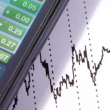by Hubert Marleau, Market Economist, Palos Management
Once again the war dominated the headlines, even though the economic prints were encouraging, oil prices tanked, long duration bond yields fell, and bankers made favourable stock market projections. The forecasts of 20 major investment banking houses were all positive, except one. Morgan Stanley was negative, but only slightly. They ranged from a low of 4400 to a high of 5200, averaging a return of 7.5% over the next 9 months.
Unfortunately, we are in a war-driven market. The S&P 500 laboriously increased only 3 points or 0.1% to 4546. There was little evidence supporting reports that the negotiators for Russia and Ukraine made some progress toward a cease-fire or claims that Russia was about to pull back from Kyiv and ready to embrace Ukraine’s overture. Ukraine, however, said it would be willing to accept neutrality and discuss territorial claims. Russia is likely to be intransigent. Support for Putin has surged among Russians following his invasion of Ukraine, according to the country’s leading independent pollsters. Some 83% approved of Putin’s actions. Russia is reaping a massive windfall on energy exports. And as long as hard currency (Dollar or Euros) is allowed to flow alongside oil and gas, Putin has a lifeline.
Herein lies the risk. The longer the war lasts, the greater the uncertainty of power politics and greater the volatility of the commodity markets. The situation needs to be resolved because the price of everything that Russia produces - oil, gas, metals and wheat - has violently ripped higher. The process of trading is nuts. Prices jumped and dropped dramatically, significantly raising the cost of trading those commodities. Clearing houses are asking for higher margins, and banks have raised the cost of hedging. They know that if anything is going to break it’s going to be the commodity markets. So far, however, so good. Risks have eased as commodity prices have moderated. As a matter of fact, central banks and derivative-regulators said that they were keeping an eye on those sensitive markets, but added that nothing has come to them that’s been overtly concerning. No one seems to care that there is a war in Europe. The belief is that somewhere, somehow, and sometime this nightmare will end. Eventually, one side will make a military breakthrough.
The Stock Market and the Yield Curve
Instead, traders and speculators are starting to look elsewhere for direction. The yield curve will become the new topic of conversation, because key portions of it actually inverted on Friday, flashing a recessionary signal. When short rates are higher than long ones, the curve is said to be inverted. It's not a good omen for banks, who are the main supplier of credit to the economy, because it makes it almost impossible for them to pocket a profit on what is considered normal business. It forces them to extend their neck in the very risky arena of loan making. As a rule, an inverted yield curve tends to reduce the economics of bank lending, and therefore loan growth, which by ricochet leads to either a slowdown, a growth recession or a flat-out recession.
Although the job market is too strong to deter the Fed from raising rates, seasoned investors are realising that yield curves, while good market-based predictors, are not a foolproof indicator of what’s to come. Thus there is faith that Powell will be able to pull off “Immaculate Disinflation,” as it has been dubbed by many critics. Interestingly, for all the chatter about the evil effect of an inverted yield curve, investors are generally siding with Mr.Powell.
In fact, it turns out that curve inversions are not the danger points for stocks, as many pundits broadcast. Bloomberg’s Garfield Reynolds illustrated that the thing to really worry about is when curves re-steepen. The S&P 500 declined in early 2000s, 2008-09 and again in 2019 after two-year treasury yields dropped back under 10-year yields to reverse the inversion. The reversion spelled the recession. While there has never been a recession without inverted yield curves, not all recessions were caused by them. There is a distinction between correlation and causation. The 1973-1974 and the 2020 recessions were caused by exogenous factors like the Arab oil embargo and the Pandemic. Moreover there have been several false alarms, e.g. 1965 and 1998.
Why This Time Could Be Different
The first thing to understand is that bond yields, across their duration-spectrum, are guided by rational expectations composed of mathematical formulae. That is why of all the indicators that are out there, the bond market is where any analysis should start.
At the time of this writing, yields on 3-month treasury bills were 187 bps lower than on 5-year notes and ten-year treasuries were 7 bps higher than 2-year notes, while the 30-year Treasury were yielding 13 bps less than the five-year notes.The shape of the yield curve is presently giving its listeners three messages. Firstly, the Fed’s policy rate would have to rise by as much as 200 bps before gaining on the 2.25% neutral rate, one which is supposed to keep the economy running on an even keel basis. Secondly, the Federal Funds Rate is expected to rise another 175 bps over the next 9 months. Thirdly, the Fed’s policy rate will probably start to fall in two years' time.
Inversions can fail to give correct results, especially if they don't coincidentally collaborate with five big economic indicators that weigh heavily in the cycle identification process. They are: industrial production, retail sales, money supply, personal income and employment.
As a matter of fact, the behaviour of these five main economic indicators is diligently tracked by the NBER and the Federal Reserve, for in the end they are the ones that determine if we are about to enter a slowdown, growth recession or a recession. They need to turn negative - a mere rolling over is not enough - to confirm if bond yields are indeed presaging a recession. In this connection, the call for an imminent end to the current business cycle is far from a “fait accompli” because the big data points do not support the claim that a recession is in our midst.
- For consecutive months, U.S. industrial production came in stronger than anticipated. February’s increase of 0.5% followed January’s 1.4%. On a year-ago basis, the index was up 7.5%. Total capacity utilisation was 77.6%, suggesting that there is still room to expand output.
- Retail sales added 0.3% to their January surge of 4.9%, registering a whopping increase of 17.6% year-over-year. This is informative: the gains were broadly base.
- The Federal Reserve Board’s February report showed that the money supply grew 11.0% from a year ago. It has decelerated to an annual rate of 7.6% in the past three months. Yet it is comfortably above the 4.5% threshold which has normally accompanied the long term growth and inflation trends of the U.S. economy.
- Personal Income increased by 0.5% in February over the prior month, as the unemployment rate dropped and employers scrambled to hire new workers with better wages.
- U.S. job growth continued at a robust pace. The economy added 431,000 jobs in March and the unemployment rate fell to 3.6% from 3.8% in February, even though more workers are returning to the labour force. The labour participation rate is now 62.4%. Year-over-year, the employment level is up 5.0%, having accelerated in the last three months to an annual of 6.4%. This is bound to continue because there are 11.3 million job openings. That’s more than 7.0% of the labour force. Thus, the Sahm rule, which says that the economy is in a recession if the average of the unemployment rate over three months rises a half-percentage point or more above its low over the previous year, is not presently a concern.
Being a Bear Is Risky
The median amount of time between the initial inversion of the yield curve and the onset of a recession, if there is to be one, is between 16 and 20 months. A lot of things can happen over such a long time. Given the speed at which this cycle is moving, just about anything can suddenly alter the outlook and/or the outcome.
Thus, the yield curve is not a reliable timing tool. Brian Levitt of Ivesco Canada, made the astute observation that the inversions of 1988 and 1998 missed superior market gains of 34% and 39%, respectively. He added in a report to AdvisorAnalysts that the medium return of the S&P 500 from the date in each cycle, when the yield curve inverted to the market peak, is 19%. WSJ’s James Mackintosh wrote: “It is hard to stick to bearish convictions when stocks keep going up.” There must be reasons.
The NY Fed has built a probability model based on the idea that the more inverted the yield curve - the 3-month to the 10-year - the recession is more likely. At the moment, the possibility isn’t very likely. The model puts the chance of a recession in the next 12 months at 6%. Fed chairman Ben Bernanke said that research at the Fed concluded that what really matters was the gap between 3-month yields now and the implied three-month yield in 18 months’ time. If traders are betting on lots of rate cuts in the next 18 months, they’re expecting a recession. Right now, they are not.
Thus the disorderly conduct of the bond market should perhaps be treated with utmost attention and prudence. Peter Atwater, of the Financial Time, made the astute observation that the bond market sentiment has been wildly impetuous, following impulsive comments of deem experts to policymakers. Last week, I wrote that something strange was going on. Short yields were rising, reflecting the anticipation of where the policy rate is heading while long rates were also rising, reflecting the expectation of further growth.
Inverted yield curves have recession accuracies only when long yields also fall. This has not been the case this time. Productivity gains are very strong, running at the annual rate of 2.2% over the past two years compared to only 0.9% during the decade ended in 2019. In this regard, the anticipated decrease in the money supply, and increase in the cost of money, are likely to reduce inflation much more than growth. Judging by the Fed funds futures curve and the performance of the big economic indicators, combined with the encouraging outlook for productivity, gliding into a soft-landing, without having to raise the policy rate much above the neutral rate seems probable.
The economy will likely continue to expand, albeit at a much slower pace than what we experience in 2021. I think the growth trend will run around 1.25% - a desirable rate to help ease the pain of persistent inflation. The Atlanta Fed has a growth estimate of 1.5% for Q1. Last week, Wells Fargo provided the street with the latest inflation forecast. The bank is projecting an annual rate of inflation of 2.0% by mid-2023. What is clear and present is that yields in the
Treasury, Corporate and Mortgage markets are still considerably negative in real terms. Upticks in those rates are more likely to take a little gloss off real economic growth than kill the interest-sensitive sectors, such as housing, consumer durables and business capital spending. Goldman’s financial index, adjusted for inflation, shows easy monetary conditions, and suggests that they would remain so even if the Fed were to tighten more than the market expects.
As Jay Barry, head of JPMorgan’s U.S. government bond strategy, reported in the Barron’s, the Fed has acquired more than 25% of the U.S. Treasury market through its quantitative-easing asset purchases. They have ballooned the central bank’s balance sheet to nearly $9 trillion, more than double its size at the beginning of March 2020. So the Fed’s outsize impact will continue, even as it begins to trim its holdings. This is also true for other major central banks. Thus, the supply of capital around the globe is very plentiful, which means that lending rates should stay relatively cheap making borrowing cost manageable.
Bloomberg’s John Authers added that it is possible that the current flattening of the yield curve is the result of distortions caused by the monetary intervention of the last decade. The Fed's relentless buying of bonds has played a key role in keeping the yield curve tighter than it would have otherwise been without accommodation. Michael Contopoulos of Richard Bernstein Advisors makes the case that the true fair value of the 2s10s spread is around 175 bps and not the current 7 bps.
Theoretically, the curve is neither flat nor about to invert. Thus a recession is not in sight. In fact, it's hard to think of having one when there is an excess of job openings in the economy and of personal savings in the financial system. These are two big reasons why consumer confidence has not collapsed. The labour-market differential - the share of people saying jobs are plentiful minus those who say they are hard to get - rose to the highest level in records reaching back to 1978.
The Economy Sits at a Crossroads
While the aforementioned near term factors - like the Fed’s policy effect of the money supply, the pandemic consequence on the supply chain and the exogenous shock of the war on ressources - triggered a bout of rapidly rising inflation, which should unwind as the monetary stance becomes tighter, and as soon as the cyclical, out of the ordinary demand for good and services starts to fall back to to pre-pandemic trends.
However, long-term investors should appreciate that the secular inflationary effect of de-globalisation will become more entrenched over time. Richard Berstein Advisors produced a paper on this subject matter and concluded that globalisation may have reduced secular inflation by as much as 2.0%. Investors should therefore set their long-term strategic plan on a secular inflation rate of 3.5%. If this is indeed how it’s going to turn out, the investment scenario would resemble what took place in the 1950s, which were plagued by the lack of supply.
The response was capital spending and pro-inflation assets. Somewhere down the road, once the cyclical forces disperse, sectors like Energy, Materials and Industrials will tend to outperform other sectors, including Information Technology and Consumer Services. The era of secular disinflation ended with President Trump.
Copyright © Palos Management















